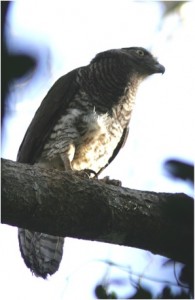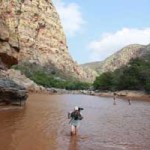Currents research on raptors in Madagascar by Lily de Roland Arison

Madagascar, the fourth largest island in the world and 250 km east of Africa, has 23 species of raptors of which 17 and 6 are diurnal and nocturnal species, respectively. Of these 23 species, 13 are endemic to the island. Since the installation of The Peregrine Fund’s Madagascar Project in 1990, two endangered species were rediscovered: the Madagascar Serpent-eagle Eutriorchis astur and the Madagascar Red Owl Tyto soumagnei.
The Peregrine Fund’s Madagascar Project is currently and continues to conduct research and conservation on raptors with a focus on three endangered and threaten species: Madagascar Fish Eagle, Madagascar Serpent-eagle and Madagascar Red Owl. Below describes some of the research and highlights on these species from previous years and in 2008.
Madagascar Fish Eagle Haliaeetus vociferoides
We have monitored Madagascar Fish Eagles at two sites on the west coast of Madagascar. The first site is the Manambolomaty Lakes Complex which has been monitored since 1990 and with the highest concentration of nesting fish eagles in western Madagascar and the second site is in the Tambohorano region 225 km north of the Manambolomaty Lakes Complex. The Manambolomaty site is formed by a complex of three lakes surrounded by a dry deciduous forest. This site has 12 territorial pairs of fish eagles, and within the same area is the Antsalova region where we have monitored an additional 15 nesting pairs. The second Tambohorano site is formed by the fourth largest in Madagascar and it is surrounding by dry deciduous dry forests and palm trees. This site has 8 nesting pairs. We conduct fish eagle productivity surveys three times during the breeding season: during the incubation period (to verify the number of eggs), during the nestling period (to verify number of young) and during the post-fledgling period (to determine the number of young successfully fledging). The nesting population at Manambolomaty Lakes Complex has an unusually polyandrous breeding strategy where one dominated female has two males associated with her. The reason for this unique breeding strategy of having three adults at a nest may be due to the quality of the habitat and resources available where one bird is the helper and is waiting in a territory for an opportunity for breeding.
Madagascar serpent-eagle Eutriorchis astur
Since the rediscovery of this species in 1993 on Masoala Peninsula in northeastern Madagascar, only 6 nesting attempts have been observed and all by The Peregrine Fund researchers. The most recent observed nesting attempt occurred in 2008 at Bemanevika in northwestern Madagascar in a transition rainforest, 200 km northwest of the 5 nesting attempts observed on Masoala Peninsula. This pair at Bemanevika was first observed during the courtship and nest building period during September 2008, eggs were laid in late September and at the beginning of November two nestlings hatched. All previous documented nesting attempts on Masoala Peninsula had been one-egg clutches. The two young were radio-tagged during December prior to fledging and in January 2009 both young fledged successfully. The two young dispersed from their natal nesting territory several months later when they became difficult to radio track in the hilly rainforest habitat at this site. During July 2009, one radio-tagged young was surprisingly found 4 km from its nest site and doing well. The Peregrine Fund biologists and technicians are continuing to collect data on their ranging behaviour when possibly. Of the six documented nesting attempts, 5 on Masoala Peninsula and the one described above at Bemanevika, this was the first record of two eggs laid and two young fledging.
Madagascar Red Owl Tyto soumagnei
One doctoral student at the University of Antananarivo (Madagascar) studying the owl community in the Bemanevika forest located one territorial pair of Madagascar Red Owls. The student radio-tagged both birds and with the aid of the radio transmitters the second know nest was discovered for this cryptic species, since its rediscovery in 1994. The nest was inside a natural cavity of a snag (dead tree) 22 m above ground. The presumed female began to visit and stay inside this cavity during the last week of May 2009. This breeding attempt was several months early than the documented nesting attempts on Masoala Peninsula from 2005 to 2007. Unfortunately, during the first week of August a strong rainstorm passed through the area snapping the snag containing the nest cavity and the young owl died. New data was recorded on their nesting behaviour and food habits, especially from this transitional rainforest of north-western Madagascar. Currently, the two radio tagged adults have returned to their preferred roosting sites.





Hi there…
Wow this is some good work – I’m very jealous – I’d love to visit Madagascar one day! I’m particularly interested in the work on the Madagascar Red Owl. I’m planning to fit some radio transmitters on African Grass-Owls (Tyto capensis) in order to investigate their home range and spatial requirements. The AGO is itself a very cryptic species – although I dont think its quite as bad as the Madagascar Red Owl!
How did the student catch these owls?
I’d like to hear more about future developments of this project – so please post again!
Regards
Matt Pretorius
(Tshwane University of Technology – South Africa)